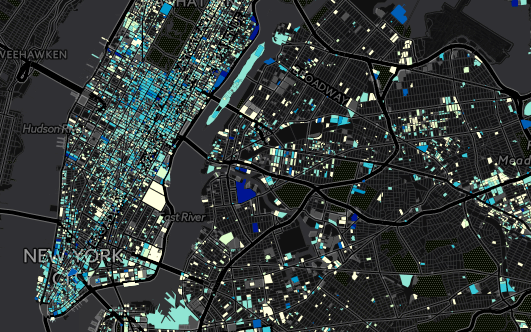Tag: green-building
June 26, 2024
GreenHomeNYC Passive House Tour: Sendero Verde

Come join GreenHomeNYC in partnership with Passive House Network to take a tour of the largest multifamily residential Passive House in the United States: Sendero Verde in East Harlem, New York.
The event fee is $10 for general admissions and $5 for student admissions. Please note we have a limit of 45 people, so you must secure a ticket in order to attend.
(more…)June 27, 2020
Interview: Reducing Greenhouse Gases from Buildings—Filling the Skills Gap
By Jude Jussim Tom Sahagian knows there’s no time left to dawdle in controlling the greenhouse gas (GHG) emissions from New York City’s buildings. The problem: There’s a shortage of people with the right skills to do it. Sahagian is not talking about policy wonks. “The life of the mind is not what’s going to get us to solving the climate crisis. Pontificating doesn’t do it. You need people who can actually physically do what’s required.”
Sahagian, a GreenhomeNYC board member with many years of experience as an energy efficiency consultant, believes that to dramatically decrease building-generated GHGs, the city’s buildings will have to be powered with clean electricity (e.g. wind or solar) rather than fossil fuels.
An Electrifying Challenge
“New York City needs to convert a thousand buildings a year for the next 30 years,” he says, “which will take hard work and coordination and commitment—and contractors and workers with the right skills. And right now, we have a shortage of those people.”
(more…)
Tom Sahagian knows there’s no time left to dawdle in controlling the greenhouse gas (GHG) emissions from New York City’s buildings. The problem: There’s a shortage of people with the right skills to do it. Sahagian is not talking about policy wonks. “The life of the mind is not what’s going to get us to solving the climate crisis. Pontificating doesn’t do it. You need people who can actually physically do what’s required.”
Sahagian, a GreenhomeNYC board member with many years of experience as an energy efficiency consultant, believes that to dramatically decrease building-generated GHGs, the city’s buildings will have to be powered with clean electricity (e.g. wind or solar) rather than fossil fuels.
An Electrifying Challenge
“New York City needs to convert a thousand buildings a year for the next 30 years,” he says, “which will take hard work and coordination and commitment—and contractors and workers with the right skills. And right now, we have a shortage of those people.”
(more…)
March 3, 2019
Can NYC’s Energy Use Data Save The Earth?
By Warren Berger On Earth Day 2015, New York City Mayor Bill de Blasio announced One New York City: The Plan for a Strong and Just City (OneNYC). As part of the plan, Mayor de Blasio committed New York City to reduce carbon emissions by 80 percent by 2050 from 2005 levels (80 x 50), with an interim target to reduce emissions 40 percent by 2030 (40 x 30). But meeting those targets requires a good understanding of where the City’s emissions come from. New York City Buildings cause 75% of New York City’s carbon emissions. The residential sector accounts for 37 percent of the City’s total emissions, making it the largest single source of emissions in the City. Collecting energy use data in these buildings is certainly a good place to start, but will that be enough to meet the City’s aggressive goals and address the climate change challenge in time?
On Earth Day 2015, New York City Mayor Bill de Blasio announced One New York City: The Plan for a Strong and Just City (OneNYC). As part of the plan, Mayor de Blasio committed New York City to reduce carbon emissions by 80 percent by 2050 from 2005 levels (80 x 50), with an interim target to reduce emissions 40 percent by 2030 (40 x 30). But meeting those targets requires a good understanding of where the City’s emissions come from. New York City Buildings cause 75% of New York City’s carbon emissions. The residential sector accounts for 37 percent of the City’s total emissions, making it the largest single source of emissions in the City. Collecting energy use data in these buildings is certainly a good place to start, but will that be enough to meet the City’s aggressive goals and address the climate change challenge in time?
According to the New York State Energy and Research and Development Authority (NYSERDA) report, Realizing Measurable Savings in Multifamily Building: Results from NYSERDA’s Multifamily Performance Program:
“It is critical to the growth of the energy efficiency market that we improve the accuracy of savings predictions to decrease the risk involved with investing in efficiency. The first step in doing so is to track and analyze actual savings data to discover changes that practitioners or program administrators can make to improve the accuracy of savings predictions and to discover which factors cannot be changed so that building owners and investors better understand the inherent risks and the likelihood of project success.”
Local Laws Aim to Capture Energy Use Data New York City’s Local Law 84 of 2009 (LL84) requires annual benchmarking data to be submitted by owners of buildings with more than 50,000 square feet for public disclosure, creating transparency for energy and water usage and informing building owners and tenants on how to make their buildings more efficient. Local Law 133 of 2016 (LL133) expands the list of buildings required to benchmark to include mid-size buildings from 25,000 to 50,000 square feet. Local Law 87 of 2009 (LL87) requires covered buildings spanning 50,000 square feet or more to audit their energy consumption and conduct retro-commissioning of building systems, including the building envelope, boiler, domestic hot water, ventilation and lighting. Compliance is Complex What has the data collection process taught us about what it takes to motivate action and effect change in the city’s residential buildings? For one thing, it’s clear from benchmarking extensions that gaining compliance isn’t a simple matter. Early last year, the City announced a deadline extension for submission of 2017 benchmarking reports for mid-sized buildings to December 31, 2018. In September 2018, the deadline was extended again, this time to February 1, 2019. In 2018, the New York City Department of Buildings and the NYC Benchmarking Help Center publicized three walk-in help sessions, which took place in May, October and November, for building owners who want more information about compliance. The center also maintains a telephone and e-mail service for owners who want more information, assistance, and answers to questions about the NYC Benchmarking Law. (more…)December 11, 2018
October Forum Recap: Passive House High Rise
By Jessica Bartolini; Photos by Olha Peralta
High-rise Passive House buildings were the subject of GreenHomeNYC’s monthly forum in October. The three presentations provided attendees with an overview of what implementing Passive House standards looks like in real life.
Gahl Sorkin Spanier of the Association for Energy Affordability (AEA) kicked off the evening with a presentation on how best to go about building a high-rise Passive House (PH) project. Kevin Brennan, formerly of AEA and now co-owner of Brennan Brennan Insulation and Air tightness, joined Gahl in sharing learnings from Passive House projects and training. AEA recently worked on an 86-unit PH affordable residence for seniors in Queens, in partnership with the non-profit organization HANAC.
 Kevin Brennan & Gahl Spanier
Kevin Brennan & Gahl SpanierGahl emphasized the importance of holding training for the various trades building a PH project, noting that the main sources of air leakage are often at details where trade responsibilities are unclear. It is key, therefore, that training not only instill understanding of PH requirements, but also recognition of the importance of collaboration and coordinating across trades. Another takeaway from AEA’s experience is that training should not include more theory or math than necessary. Gahl noted that any general contractor personnel in a supervisory role should not only receive training, but also be empowered to teach others.
May 29, 2018
March Forum Recap: Sustainable Policy 201
by Miaoru Guan The Sustainable Policy 201 Forum featured four speakers working towards sustainable, affordable housing through diverse but connected roles. Michelle Andry works at New York State Energy Research and Development Authority (NYSERDA), where she focuses on energy efficiency, clean energy, and energy affordability initiatives impacting low-income housing. Francesca Camillo, Project Manager at NYC Department of Housing Preservation and Development (HPD), assists building owners in procuring funding for rehabilitation. Elizabeth Kelly, Manager of Sustainability Programs at The Community Preservation Corporation (CPC), leverages private capital to support sustainable multi-family housing and community revitalization projects. Andrea Mancino is Director of New Construction at Bright Power, and manages team members working on ground-up new construction and commissioning projects.
The panelists discussed how effective policy can encourage wider adoption of sustainable practices in housing by facilitating financing from government sources. For example, to qualify for government funding, new construction and rehabilitation buildings must receive building certification, such as Enterprise Green Communities or LEED certification. Mancino mentioned that achieving certification as an Enterprise Green Community requires buildings to outperform standard building code by 15%. Kelly discussed how these standards help the CPC and private lenders ensure projects have fulfilled a sustainability checklist, reducing the time projects spend in due diligence. Andry added that certified buildings are eligible for NYSERDA grants as well as HPD funding.
(more…)
The Sustainable Policy 201 Forum featured four speakers working towards sustainable, affordable housing through diverse but connected roles. Michelle Andry works at New York State Energy Research and Development Authority (NYSERDA), where she focuses on energy efficiency, clean energy, and energy affordability initiatives impacting low-income housing. Francesca Camillo, Project Manager at NYC Department of Housing Preservation and Development (HPD), assists building owners in procuring funding for rehabilitation. Elizabeth Kelly, Manager of Sustainability Programs at The Community Preservation Corporation (CPC), leverages private capital to support sustainable multi-family housing and community revitalization projects. Andrea Mancino is Director of New Construction at Bright Power, and manages team members working on ground-up new construction and commissioning projects.
The panelists discussed how effective policy can encourage wider adoption of sustainable practices in housing by facilitating financing from government sources. For example, to qualify for government funding, new construction and rehabilitation buildings must receive building certification, such as Enterprise Green Communities or LEED certification. Mancino mentioned that achieving certification as an Enterprise Green Community requires buildings to outperform standard building code by 15%. Kelly discussed how these standards help the CPC and private lenders ensure projects have fulfilled a sustainability checklist, reducing the time projects spend in due diligence. Andry added that certified buildings are eligible for NYSERDA grants as well as HPD funding.
(more…)
March 18, 2018
February Forum Recap: How to be Cool and Efficient
by Yiran Song Air conditioning is increasingly considered to be a required amenity in both residential and commercial settings. But concerns about global warming and greenhouse gas emissions gives us no time to waste in achieving more energy efficient AC systems. In the February GreenHomeNYC Forum “How to be Cool and Efficient”, three industry experts provided a detailed description of the mechanics of AC systems and the industry as a whole. Systems and Relative Energy Efficiency
Brendan Casey, of Fujitsu General America, believes that the Variable Refrigerant Volume (VRV) or so-called Variable Refrigerant Flow (VRF) system is the future of AC systems. Even though VRF can be carried as cooling only, building owners and management companies in places like New York City should consider either heat pump or heat recovery systems which provide both cooling and heating. The heat recovery system carries higher installation cost, but it can provide both heating and cooling at the same time to different zones based on demand with only one control.
(more…)
Systems and Relative Energy Efficiency
Brendan Casey, of Fujitsu General America, believes that the Variable Refrigerant Volume (VRV) or so-called Variable Refrigerant Flow (VRF) system is the future of AC systems. Even though VRF can be carried as cooling only, building owners and management companies in places like New York City should consider either heat pump or heat recovery systems which provide both cooling and heating. The heat recovery system carries higher installation cost, but it can provide both heating and cooling at the same time to different zones based on demand with only one control.
(more…)
March 1, 2018
January Forum Recap: The Green Catwalk
by Jenny Nicolas At the annual GreenHomeNYC Green Catwalk, seven speakers presented the latest information on everything from ventilation to greening the moving industry to O&M to-do lists within the sustainability space. Part 1: Eat, Breathe, Move, & Check Sustainably Changing Our Relationship with Food Ricky Stephens, co-founder of AgTech X, set the stage by presenting some of the biggest flaws within our country’s current food system. He indicated that 80% of the food grown today is not meant for human consumption, with 40% grown to support animals and 40% to be processed into biofuels. Additionally, though the plant kingdom is diverse, 84% of total US cropland is dedicated to just three crops: corn, soybean, and wheat. The long term prospects for the system are also in jeopardy as farming is not attracting new folks to the industry – the average age of a U.S. farmer is 58. What can be done to fix our current system? The goal of AgTech X is to create a new food economy, using urban farming as a vehicle to educate, decentralize, and make farming exciting again. AgTech X fosters a collective community by hosting classes, workshops and tours. Its co-lab workspace supports decentralized urban farming methods like Farm One and Smallhold, indoor farms housed in restaurants that produce farm-to-table microgreens. And a recent “Intro to Aquaponics” class by Oko Farms explained the closed-loop system of raising fish, creating fertilizer for plant growth and filtering the water. While urban farming is not a new concept, innovations in the past five years are making it a more intriguing career option for young professionals! (more…)December 4, 2017
GreenHomeNYC Year in Review: Taking on the Environmental Challenge
by Pamela Berns It’s been a year marked by extreme weather events, with hurricanes, fires, droughts, and flooding all across the globe. In the United States we saw Houston drown and Santa Rosa burn just a few months after Trump’s pullout from the Paris agreement in June. Climate advocacy groups, local policy makers, corporations, entrepreneurs, individuals, and nonprofits all stepped up their game in defense of the planet, and GreenHomeNYC was no exception. Thanks to the dedication of our volunteers, we were able to deepen our commitment to providing education and calls to action. Our speakers and our blog writers shared critical information on local policy, business actions, and academic initiatives. Record numbers of event attendees turned up to hear from innovators in energy, food waste, recycling, and sustainable building. Green careerists came out to find out where to point their compasses in the new paradigm. We’re proud of the hard work that went into this challenging year, and hope that our contributions made a difference. Here are just a few GreenHomeNYC highlights for 2017: (more…)December 3, 2017
NYC’s 80 x 50 Goal: Is it Realistic? How Do We Get There?
By: Tom SahagianNovember 28, 2017
November Green Building Tour Recap: Building Towards Resilience
by Brigitta Berze It’s been five years since Hurricane Sandy hit the East Coast, leaving a trail of destruction in the New York area. During the “Building Towards Resilience” Green Building Tours event, Henry Gifford of Chris Benedict R.A., led a tour through 327 and 334 East 8th Street – two Lower East Side buildings that were affected by the hurricane – providing a firsthand look at renovations that were made in the aftermath of the natural disaster.
It’s been five years since Hurricane Sandy hit the East Coast, leaving a trail of destruction in the New York area. During the “Building Towards Resilience” Green Building Tours event, Henry Gifford of Chris Benedict R.A., led a tour through 327 and 334 East 8th Street – two Lower East Side buildings that were affected by the hurricane – providing a firsthand look at renovations that were made in the aftermath of the natural disaster.
The tour began in the noisy basement of 334 East 8th Street, with a description of the damage after Hurricane Sandy, including the conditions that the workers had to endure. The elevator in this building is not counteracted by weights to lift the elevator car, but instead uses oil mixed with other chemicals in a hydraulic elevator machine. As the water rose to about six feet above the basement floor, the oil and chemicals mixed with the flood waters, creating a hazardous condition for workers. The slippery mix of oil, water and sewage caused the superintendant to get a foot infection that landed him in the hospital for three days.
(more…)

